| Columns Retired Columns & Blogs |
Wilson WATT Series 3-Puppy 2 loudspeaker Measurements
Sidebar 2: Measurements
The majority of the measurements were performed with a DRA Labs MLSSA acoustic analysis system, with a B&K/DPA 4006 ½" microphone. Looking first at the Series 3 WATT's impedance with the Puppy, the tuning of the WATT's reflex port lies at 36Hz; without the Puppy, the WATT 3's impedance peaks at 21.6 ohms at 74Hz (not shown). With the Puppy, this peak disappears, to be replaced by the Puppy's two bass peaks, the minimum between them at 27Hz indicating the Puppy's port tuning frequency. The slight impedance peak centered on 17.5kHz, just above a typical adult's range of hearing, is due to the primary tweeter resonance. Whereas the first WATT plunged down below half an ohm in the low treble and the series 2 speaker down to a still low 1.25 ohms at 2190Hz, the latest WATT can be seen to reach a more sensible minimum of 1.75 ohms at the same frequency (fig.1). While this will not present pedigree solid-state amplifiers with any drive problems, tube designs are best avoided given the overall low impedance above 150Hz.
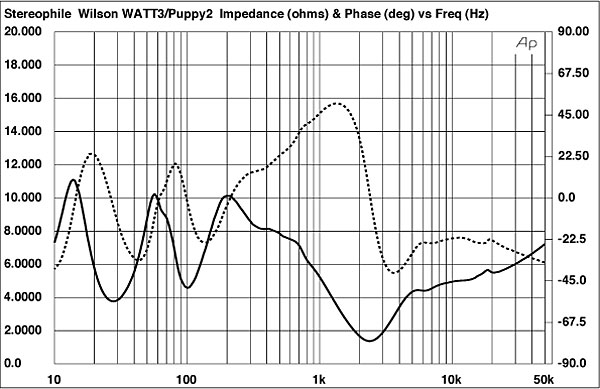
Fig.1, Wilson WATT 3/Puppy 2, electrical impedance and phase (2 ohms/vertical div).
On the other hand, the high sensitivity—a 1/3-octave warble tone centered on 1kHz and with a level of 2.83V RMS—measured 8.5dB higher than a Rogers LS3/5A, implying a sensitivity of 91dB/W/m. Even a 50W amplifier, provided it can handle low impedances without stumbling, will raise adequate levels from a pair of WATTs in all but very large rooms.
Turning to the time domain, fig.2 shows the speaker's impulse response on the tweeter axis and parallel to the floor at a 45" distance, taken with a 30kHz bandwidth to show the tweeter's near-ultrasonic ringing. For comparison, fig.3 shows the identical measurement made on the WATT 2. Though hard to make out at the scale at which these graphs have to be reproduced in the magazine, the Series 3 speaker is somewhat better behaved in the manner in which the pulse decays, though the ultrasonic ringing is a little more pronounced. Note, however, that a couple of small reflections of the impulse can be seen in both impulse responses about 1ms after the initial pulse. I'm not sure what these are from; perhaps from the pulse reflected from the cabinet rear and reemerging through the cone.
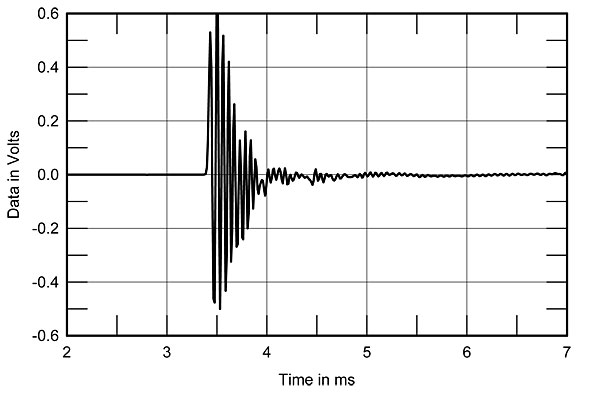
Fig.2, Wilson WATT 3, impulse response on tweeter axis at 45" (5ms time window, 30kHz bandwidth).
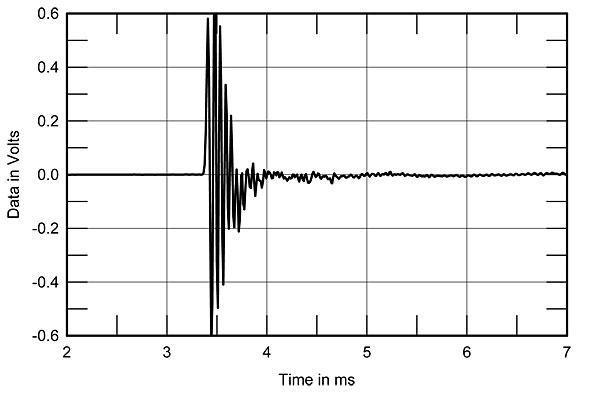
Fig.3, Wilson WATT 2, impulse response on tweeter axis at 45" (5ms time window, 30kHz bandwidth).
Fig.4 shows the WATT 3's step response on the tweeter axis. The speaker has a time-coincident, right-triangle shape, with the outputs of the two drive-units arriving at the microphone at the same time, though some lower-frequency ringing is evident.
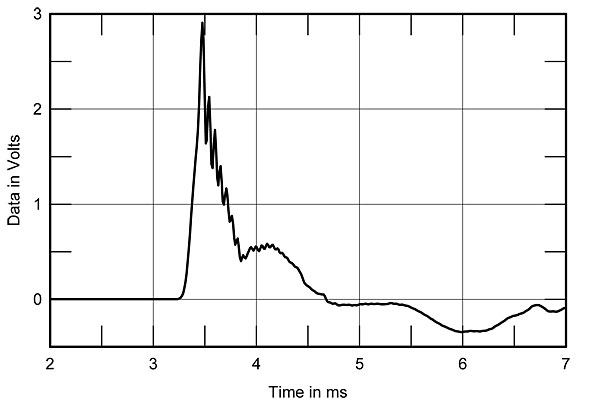
Fig.4, Wilson WATT 3, step response on tweeter axis at 45" (5ms time window, 30kHz bandwidth).
Laterally, the WATT offers even dispersion in the treble, maintaining its response up to 15° off-axis. Fig.5 shows the way in which the WATT's response changes according to listener ear height, with all the curves normalized to the response taken just above the tweeter—flat trace—which is where the best measured integration between the drive-units appears to be at this distance, as well as where I found the speaker to sound smoothest in the low-mid treble. It can be seen that the axis on which I took the impulse response in fig.2, level with the tweeter, is not ideal in that a serious energy notch appears at the crossover frequency. This notch, a space-dependent interference effect due to the drive-unit outputs being 180° out of phase at this microphone position, is also apparent on the axis midway between tweeter and woofer, which, according to the Wilson handbook, is the target axis.
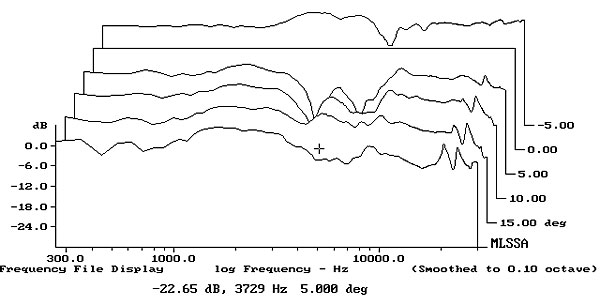
Fig.5, Wilson WATT 3, vertical response family at 45", normalized to response 7.5° above tweeter axis, from back to front: differences in response 15° above axis, reference response, differences in response 7.5–30° below axis.
Remember, however, that this measuring position is of necessity unrealistically close to the speaker, in order to keep reflections of the impulse sufficiently far away in time to get maximum midrange resolution. At more typical listening distances—such as the 2.5m in my room—any such interference effects should be inaudible, as indeed turned out to be the case. The rearmost trace of fig.5 shows that a listener sitting with his or her ears appreciably more than 37" from the ground, or one standing at the rear of the listening room, will hear considerably more low-treble energy than one sitting on the optimum axis.
The reference response for fig.5 is shown in fig.6, to which I have appended the nearfield responses of the woofer and port, the former measured with the microphone almost touching the woofer's dustcap. The plotted levels of these with respect to the upper-frequency curve are only approximate, but I used the in-room measurement of the speaker's extension as a guide (see later). These measurements confirm that, as expected from its overdamped reflex alignment and as heard during the auditioning, the WATT's bass is lightweight when used without the Puppy, the rear-facing port only adding marginal reinforcement below 70Hz or so.
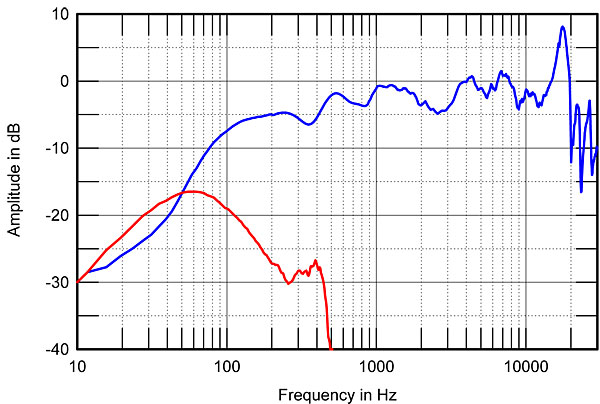
Fig.6, Wilson WATT 3, anechoic response on tweeter axis at 45", corrected for microphone response, with nearfield woofer and port responses plotted below 200Hz and 500Hz, respectively.
It can also be seen from fig.6 that the WATT features, overall, a rising trend through the midrange, with a slightly peaky response. This correlates nicely with the somewhat forward tonal balance, and may well contribute to the speaker's effortless recovery of detail and superb articulation. However, the modified Focal tweeter is quite well-balanced throughout the low- and mid-treble—and very well-behaved when compared with similar Focal tweeters used in other manufacturers' loudspeakers—while its resonance peak in the top octave will be inaudible to nearly all adults. The clean treble behavior of the WATT 3 is confirmed by fig.7, which shows the speaker's cumulative spectral-decay ("waterfall") plot. Note, however, some wrinkles in the manner in which the content of the pulse decays in the 1kHz region, this presumably due to the reflections noted on the step response.
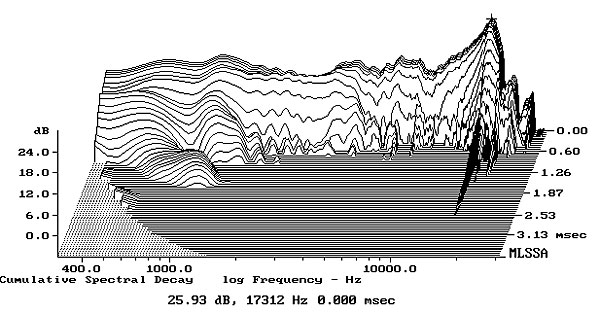
Fig.7, Wilson WATT 3, cumulative spectral-decay plot on tweeter axis at 50" (0.15ms risetime).
Measuring the effect of the Puppy when added to the system was somewhat problematical. To the right of fig.8 is shown the WATT's response on the HF axis parallel to the floor and averaged across a 30° lateral angle—note the presence-region suckout implied by fig.5—to which has been spliced the WATT woofer's nearfield response when driven from the Puppy high-pass crossover. To the left of fig.8 can be seen the nearfield responses of one of the Puppy's woofers and its rear-mounted port, driven via the subwoofer's internal low-pass filter. (Again, the plotted relative levels of these traces can only be approximate.)
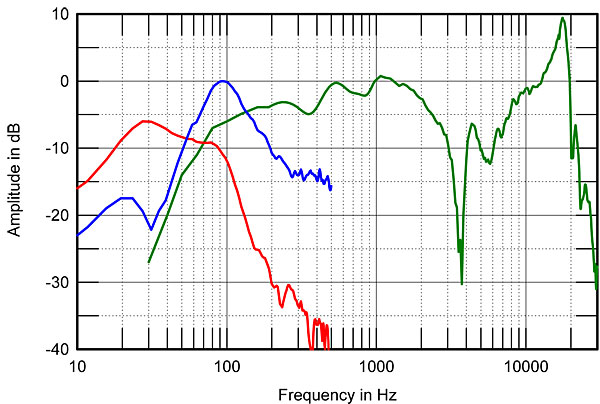
Fig.8, Wilson WATT 3, anechoic response on tweeter axis at 45", corrected for microphone response, with WATT 3 nearfield woofer when driven by the Puppy crossover plotted below 200Hz (green) and Puppy woofer (blue) and port (red) responses plotted below 400Hz, respectively.
The Puppy woofer can be seen actually to cover just a relatively small region in the mid–upper-bass, from 62Hz to 152Hz, to judge by the –6dB points. The minimum in the woofer output at 28Hz confirms the port tuning indicated by the impedance plot (fig.1), as does the broad peak in the Puppy port's output centered on the same frequency. But the Puppy is definitely a woofer rather than a subwoofer, to judge by these measurements. Yes, it does usefully extend the WATT's output down to the bottom of the double-bass and bass guitar's E-string regions. But an important effect on the sound of the WATT will be to reduce the stress on the latter's 6.5" woofer, allowing a higher playback level before audible strain sets in.
However, you can see from fig.8 that even when fed from the Puppy, the WATT still reproduces an octave or so of upper-bass frequencies in parallel with the Puppy, rather than crossing over cleanly. To see why this should be the case, I loaded the end of the Puppy's "Puppy Tail" with an 8 ohm resistor and plotted the crossover's fundamental high-pass function. This is shown as the top curve in fig.9, which reveals a smooth first-order rolloff, with its –3dB point at 100Hz, the –6dB point at 50Hz. Replacing the resistor with the WATT 3 gives a very different result—the lower curve—due to the interaction between the filter's source impedance and that of the WATT. Remember that the WATT's impedance features a 22 ohm peak at 74Hz; this results in a boost in the WATT's drive signal in this region which to some extent counteracts the crossover's bass rolloff. However, this impedance interaction also suppresses the input to the WATT in the upper bass, as well as slightly accentuating the speaker's already forward treble.
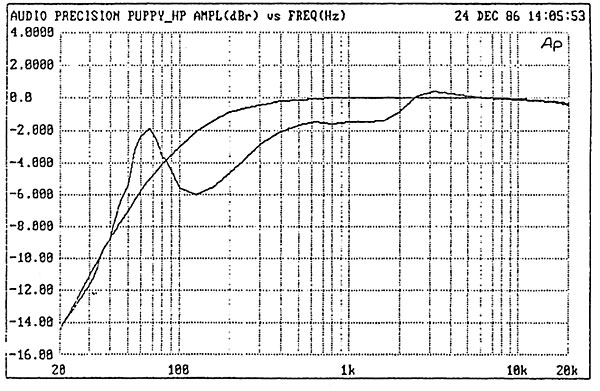
Fig.9, Wilson WATT Puppy, high-pass crossover response when loaded with an 8 ohm resistor (top trace at 1kHz) or loaded by the WATT 3 (bottom trace at 1kHz).
However, the moment of truth for all these individual measurements is how the speaker actually performs in the listening room. After David Wilson and Tierry Budge had set the speakers up to their satisfaction in my room, I performed a series of ten 1/3-octave spectrum analyses for left and right speakers individually in a 72" by 20" window centered on the listening seat, using a pink-noise source and the magazine's Audio Control Industrial SA-3050A analyzer. Averaging these in-room responses minimizes the effect of room standing waves, and I have found this average curve, slightly weighted toward the spectra at the listening seat, to correlate nicely with the subjectively perceived balance of loudspeakers in my room.
The resultant spatially averaged curve for the WATT 3 and Puppy is shown as he blue trace in fig.10, as well as the curve for the WATT 3 on its own (still sitting on the Puppy but driven directly, red trace). As expected from the anechoic responses, there is an excess of energy in-room in the WATT's top octave due to the tweeter resonance. As noted earlier, this only manifests itself as an added spitty edge to LP surface noise. Moving down in frequency, the entire treble and upper midrange are commendably smooth, with perhaps a slight excess of midrange energy correlating with the forward balance noted in the listening sessions. Perhaps due to the complex interaction between the WATT and the Puppy crossover, the upper-bass region is exaggerated in level, with a rolloff below the Puppy woofer region relieved by the Puppy port output. The usable bass response in-room extends down to the 30Hz region. Note that without the Puppy, the WATT's response starts to roll off below the slight midrange prominence in the 630Hz region, giving a lightweight tonal balance with the entire bass region suppressed. However, this curve does not reveal the beautifully articulate nature of what low frequencies the WATT manages to produce on its own!
To me, the curve in fig.10 suggests a fine balance achieved by the speaker's designer: despite the occasional measured anomaly or sonic idiosyncrasy, the overall performance is both tonally correct and musically satisfying.
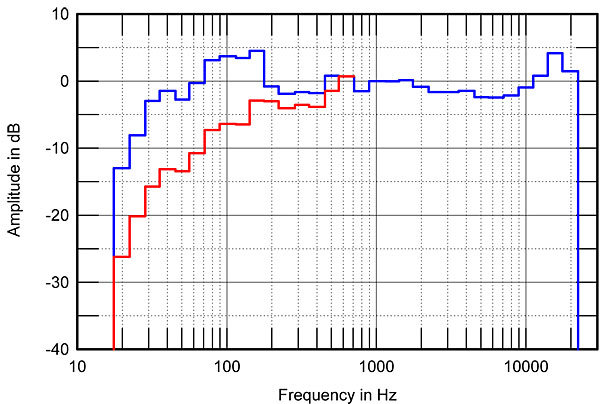
Fig.10, Wilson WATT 3, spatially averaged 1/3-octave response with Puppy in JA's listening room (Blue trace) and without Puppy (red trace).
A thought strikes me, however. The fact that the Puppy rolls off below 30Hz or so can be compensated for by buying (at great expense) Wilson Audio's WHOW powered subwoofer. But for those of us without such deep pockets, there's another, so far unrealized solution. Given the overdamped nature of the Puppy's low-frequency alignment, its already good extension, and the fact that the Puppy's Dynaudio drivers have excellent excursion capability and high power handling, it would seem a logical step for the benefit of those in smaller rooms who don't need high playback levels, for someone to offer a gentle bass-equalization filter, along the lines of those offered for the B&W 801 and 800. This could extend the response to 20Hz, without too much boost and without adding high levels of distortion—as long as not too much wind noise is induced in the relatively small port—as well as providing a mild correction in the upper bass to eliminate the in-room "hump." What do you say, David? Get John Curl to put a suitable circuit together.
Finally, at the time of the original review, I had not yet started examining loudspeaker cabinet resonant behavior. I did so subsequent to the publication of this review, and fig.11 shows a cumulative spectral-decay plot calculated from the output of an accelerometer fasted to the center of the WATT's sidewall. Though a single strong resonance can be seen at 355Hz, this may well be too high in frequency and have too high a Q to have audible consequences.—John Atkinson
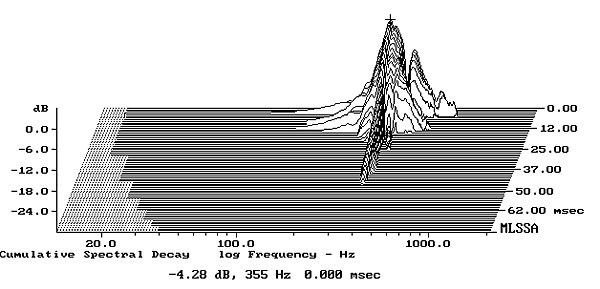
Fig.11, Wilson WATT 3, cumulative spectral-decay plot calculated from the output of an accelerometer fastened to the center of the cabinet's side panel (MLS driving voltage to speaker, 7.55V; measurement bandwidth, 2kHz).
- Log in or register to post comments

Waiting for Mr. Goodsnark
Submitted by fkrausz on October 5, 2011 - 10:04am
JA,
Great fun reading this post. Seems that you haven't let yourself be this satirical in recent years. Let me encourage you to do so whenever the muse inspires you.

Re; Waiting for Mr. Goodsnark
Submitted by John Atkinson on October 5, 2011 - 4:33pm
Great fun reading this post. Seems that you haven't let yourself be this satirical in recent years. Let me encourage you to do so whenever the muse inspires you.
This was a fun review to write, as well as being the longest review of a single product I have ever written. Can't believe it was more than 20 years ago!
John Atkinson
Editor, Stereophile




































